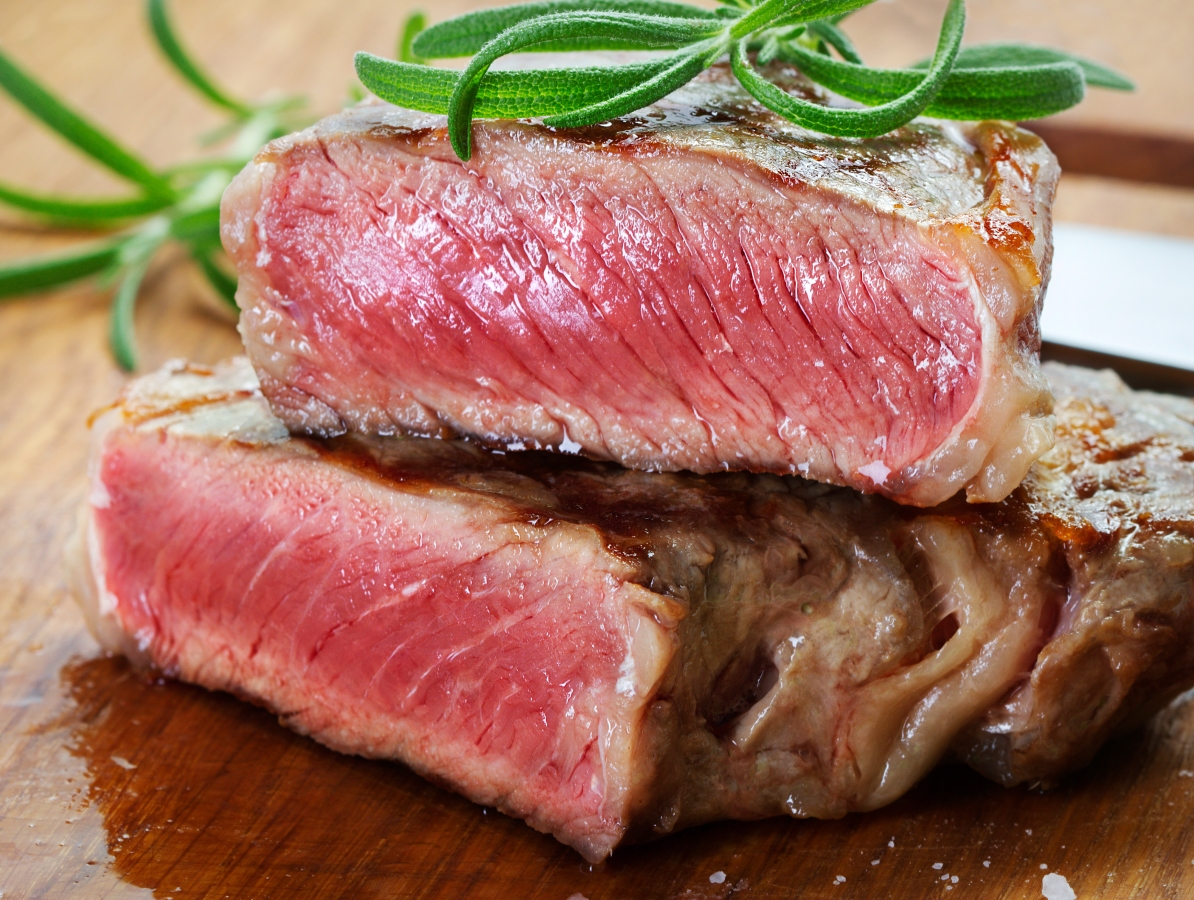Attention all meat lovers: have you ever been tempted to sink your teeth into a juicy, medium-rare steak straight off the grill? While the idea of savoring the raw, succulent flavor of a perfectly cooked piece of beef may seem appealing, you may want to think twice before indulging in this delicacy. Read on to find out why.
- Is It Dangerous to Eat Steak Raw in the Middle?
- Risks of Eating Steak Raw in the Middle - Bacteria and Parasites
- How to Safely Store Raw Steak
- How to Safely Cook and Eat Steak
- How to Eat Steak Safely in Restaurants
- Steaks From Different Meats
- Can I Eat Steak Raw in the Middle if I Freeze It First?
- Is It Safe to Eat Completely Raw Steak?
- How Can You Eat Raw Steak Safely?
- What Should I Do if I Ate Undercooked Steak?
- Questions & Answers
- Sources
Is It Dangerous to Eat Steak Raw in the Middle?
Generally speaking, there is a difference between steaks from different species. Depending on the species, meat from animals can be contaminated with different pathogenic bacteria and infected with different parasites.
This means that meat from different animals needs to be prepared in different ways.
In this article, I will give you help to know how to prepare your meat so you minimize the risk of getting sick from eating your favorite steak. Above all, what you need to know is what to do to eliminate dangerous bacteria and in some cases parasites.

In the United States, CDC estimates that 48 million people get sick and 3,000 die from foodborne diseases each year. Meat and poultry are the cause of approximately 20 percent of all foodborne diseases.
Therefore, there is every reason to know how to avoid getting sick from the meat you eat.
Risks of Eating Steak Raw in the Middle – Bacteria and Parasites
Bacteria
First of all, you need to know that all raw meat is contaminated with bacteria. Not all bacteria are harmful to humans, but animals often carry bacteria that could make humans ill.
When an animal is slaughtered, the meat is always contaminated. Some leakage of contaminated fluid occurs when the esophagus is cut to remove the heart, lungs, and liver from the carcass. Some contamination of the meat by bacteria from the animal’s stomach, intestines, and fur also occurs when it is handled at the abattoir. The contamination is often so small that it cannot be seen with the naked eye, but there is always plenty of bacteria on the surface of the raw meat.
The most important bacteria present in animals that, if not eliminated, can cause serious illness in humans include:
- Salmonella
- VTEC (Verotoxin-producing Escherichia Coli)
- Campylobacter
- Yersinia
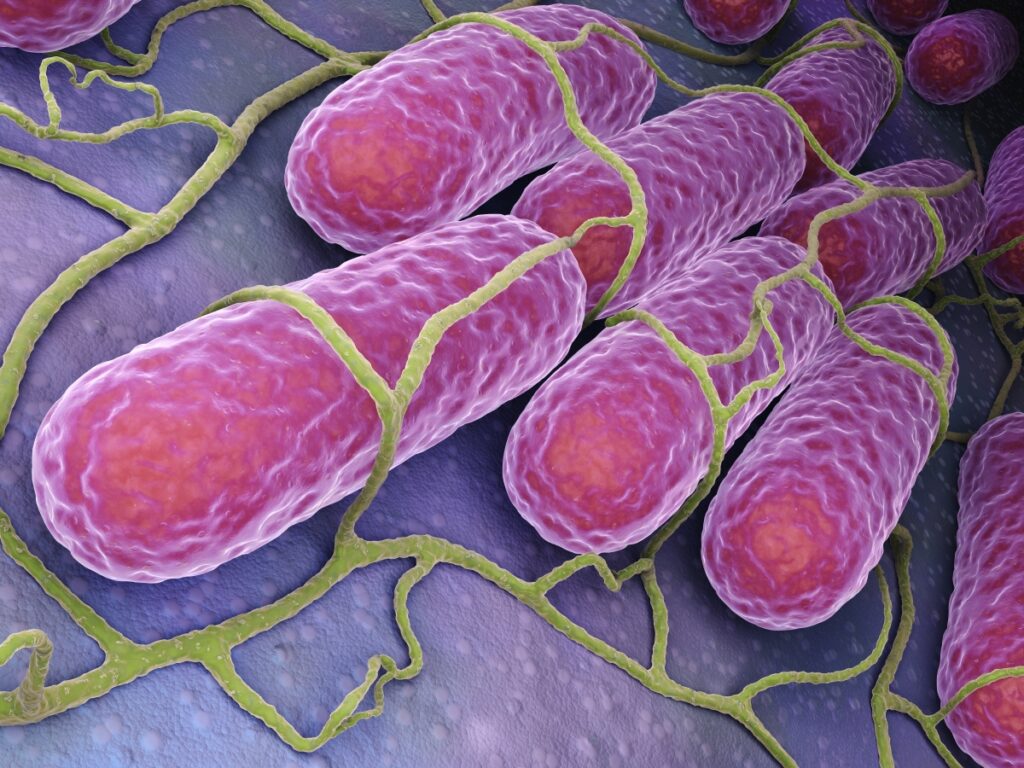
As matter of fact – even the inside of the meat can contain bacteria that can make people sick if the animal is ill when it is slaughtered. To avoid this the meat must be inspected at an abattoir.
Nevertheless, with good knowledge of preparing food and maintaining good hygiene in the kitchen, you can enjoy your meat with minimal risk of food poisoning.
Important fact:
Raw meat is always contaminated with bacteria on the surface.
Salmonella
Salmonella is a bacterium found in most of the world and most food-producing animals can carry the bacteria. The bacterium is found in the intestine, and some types can be found in the gallbladder in the liver, but it can also be present in the animal’s fur.
There are many types of Salmonella, some of which can cause serious illness in humans while others cause very mild symptoms or no symptoms at all. A common symptom in humans is diarrhoea, while a more rare but serious condition is blood poisoning, sometimes resulting in death.
Salmonella dies almost instantly at about 160°F (71°C). It takes slightly longer at lower temperatures, such as 149°F (65°C). In contrast, salmonella survives freezing.
VTEC (Verotoxin Producing Escherichia Coli)
VTEC (Verotoxin producing Escherichia Coli) is a bacterium that can sometimes be found in, for example, cattle and sheep and is most common in young animals. The animal usually carries the bacterium in its gut (also usually found in its fur) without being sick itself and it is likely that only a few bacteria are needed for a human to become ill.
There are many different types of VTEC, which can cause both mild and severe symptoms. Humans are affected differently, with the most serious conditions including bloody diarrhoea, brain damage or kidney damage. Deaths can occur. Young children are particularly susceptible and experience the most severe symptoms. The bacterium quickly dies at about 160°F (71°C) but as it only takes a few bacteria to become infected, hygiene in the kitchen is also very important.
Campylobacter
Campylobacter is a bacterium that can be found in most food-producing animals but is particularly common in birds. The animal carries the bacterium without being sick itself. The bacteria is found in the intestines or in the animal’s fur/feathers and humans are at risk of becoming ill if good hygiene is not observed in the kitchen.
Unlike Salmonella and VTEC, some Campylobacter bacteria die when the food is frozen.

Photo: “Campylobacter bacteria” by Microbe World is licensed under CC BY-NC-SA 2.0.
Common symptoms in humans are diarrhoea, but other problems such as nerve damage can also sometimes be seen. Deaths are very rare, but the disease can in some cases cause very prolonged symptoms which can also become chronic.
The bacteria die at about 160°F (71°C).
Parasites
Parasites can sometimes be found in meat. Unlike bacteria, parasites are not found on the surface but inside the meat. Some of the parasites can be detected during the inspection at slaughterhouses, while others are invisible to the eye. While most are relatively harmless, others can cause very serious symptoms in humans.
The two most important disease-causing parasites in meat are trichinella and toxoplasma.
Trichinella (Pig, Wild Boar and Bear)
Trichinella is found in meat and can cause serious illness, including death in humans. Therefore, in many countries meat from pigs slaughtered in a slaughterhouse is checked to avoid the risk of infected animals becoming food.
Trichinella are very small worms that can initially cause diarrhoea. The larvae later migrate from the intestine to different parts of the body and can cause muscle pain and prolonged fever. How sick you get depends on how many worms you ingest. In severe cases, Trichinella can cause death.
The safest way to kill the parasites is to heat the meat to 160°F (71°C). Freezing pork to 5°F (-15°C) for 20 days also works. However, freezing may be ineffective for wild boar and bear because the parasites in these animals can survive low temperatures.

Toxoplasma (Lamb, Pork, Beef, Game)
Toxoplasma is a parasite found in meat and can be found in several animal species, but is particularly common in lamb. Toxoplasma can cause very serious symptoms in people with weakened immune systems. It can also cause serious illness or even death in fetuses.
The parasite dies when meat is heated to 140-149° F (60-65°C). The parasite also cannot survive freezing at 0° F (-18°C) for three days.

The risk for pregnant women and people with weakened immune systems can therefore be reduced by:
- heating the meat until it is pink in color (free from visible blood)
- freezing the meat to 0° F (-18° C) for three days.
- To be completely safe, make sure the meat is well-done.
Important fact:
Raw meat can be infected by parasites.
How to Safely Store Raw Steak
All meat has bacteria on its surface. The packaging may also be contaminated on the outside. It is not certain that hygiene was good when the meat was packaged. Some packaging may also have broken during storage and transport. Meat juices may therefore have leaked out and contaminated other meat packaging.
It’s therefore crucial to keep raw meat and poultry away from other food that’s ready to eat and won’t be cooked. By doing this, you decrease the likelihood of cross-contamination. Cross-contamination means that bacteria from one food contaminate other foods, e.g. through hands or utensils.
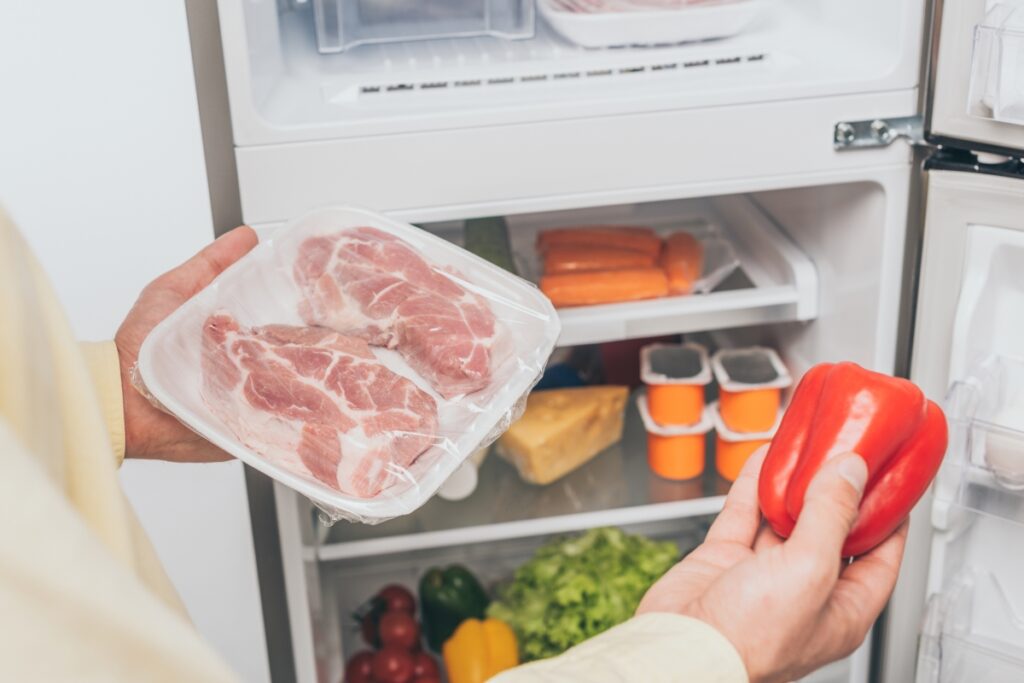
Cross-contamination can occur when handling any kind of raw meat. Always wash your hands in hot soapy water and dry them off completely before preparing food, as well as after touching raw meat or chicken. In addition, make sure that the juices from raw meat don’t come into contact with any other foods. It’s best to store raw meat at the bottom of the fridge to prevent drips onto other foods.
If you can, it’s a good idea to put the raw meat on a plate or in a pot in the fridge to collect the juices in case the packaging leaks.
Clean all utensils, equipment, and surfaces thoroughly after preparing raw meat or poultry, before coming into contact with other food. If the fridge has been contaminated by meat juices, it is important to clean and disinfect it as soon as possible.
How Long Does Raw Steak Last in the Fridge?
The raw steak will last for about 3-5 days in the refrigerator. This time frame depends on the packaging the steak came in and its sell-by date and expiration date. The USDA recommends that uncooked steak be refrigerated for 3 to 5 days before cooking or freezing.
Fresh minced meat should only be refrigerated for 1-2 days before cooking or freezing.
Raw beef, veal, lamb and pork roasts, steaks and chops may be kept 3 to 5 days.
If the meat has been handled hygienically and if the temperature is correct in the refrigerator (about 40°F), it will not grow any bacteria that can produce toxins that can withstand heating. This means that if you heat the meat properly when cooking (well-done), you can usually eat the meat without risk of getting sick, even if it has been stored in the fridge for a long time.
However, meat that has been stored in the fridge for a long time starts to rancidify and smell bad due to chemical reactions and the proliferation of various bacteria. A rancid or sour smell also means a rancid or sour taste. If the meat does not smell bad, you can eat it even though it has been in the fridge for many days. However, be sure to cook the meat through to eliminate disease-causing bacteria.

Don’t forget to take great care in washing your hands before and after handling the raw meat. Also make sure to clean the surfaces with which the raw meat has come into contact. This is even more important if the meat has been stored for a long time in the refrigerator.
How to Safely Cook and Eat Steak
If you only have one fridge – make sure you keep raw meat at the bottom and food that will be eaten without heating at the top. If you have two fridges – use one for food that will be heated and the other for food that will not be heated before you eat it.
Important: Always use separate cutting boards for raw meat and food that will not be heated before consumption.
Make sure that the cutting boards are well-cleaned before use and free of bumps where bacteria can grow. Be sure to wash the cutting boards as soon as possible after use.
Keep your worktop clean, wiping up meat juices with paper towels.
Use a moderately strong stream of water when washing hands or rinsing dirty cutting boards and utensils to avoid splashes to surfaces, other food in the kitchen and to you. If you’re unlucky, one small splash can be enough to make you sick…
For meat from different animal species – see the table below for proper handling during cooking and safe internal temperature to know when steak is cooked enough.
Safe Minimum Internal Temperature Chart
To safely cook a steak, use a thermometer and follow the recommended internal temperatures in the table below.

| Type of Meat | Minimum Internal Temperature |
|---|---|
| Beef, Pork, Veal & Lamb Steaks, chops, roasts | 145 °F (62.8 °C) and allow to rest for at least 3 minutes |
| Ground Meats | 160 °F (71.1 °C) |
| Ground Poultry | 165 °F |
| Ham, fresh or smoked (uncooked) | 145 °F (62.8 °C) and allow to rest for at least 3 minutes |
| All Poultry (breasts, whole bird, legs, thighs, wings, ground poultry, giblets, and stuffing) | 165 °F (73.9 °C) |
How to Eat Steak Safely in Restaurants

Steaks From Different Meats
Steak from cattle, for example, can usually be eaten raw in the middle, while steak from pigs should be eaten cooked through. Steak from lamb should not be eaten raw in the middle unless the meat is frozen beforehand or if the meat is heated to more than 140° F (60° C) in the core.

Chicken needs to be cooked through because there are bacteria inside the meat. This is because brine is injected into the chicken to tenderize it. Never eat raw chicken.

Can I Eat Steak Raw in the Middle if I Freeze It First?
Freezing the meat does not mean that the bacteria are destroyed, they remain and can begin to multiply as soon as the meat thaws again.
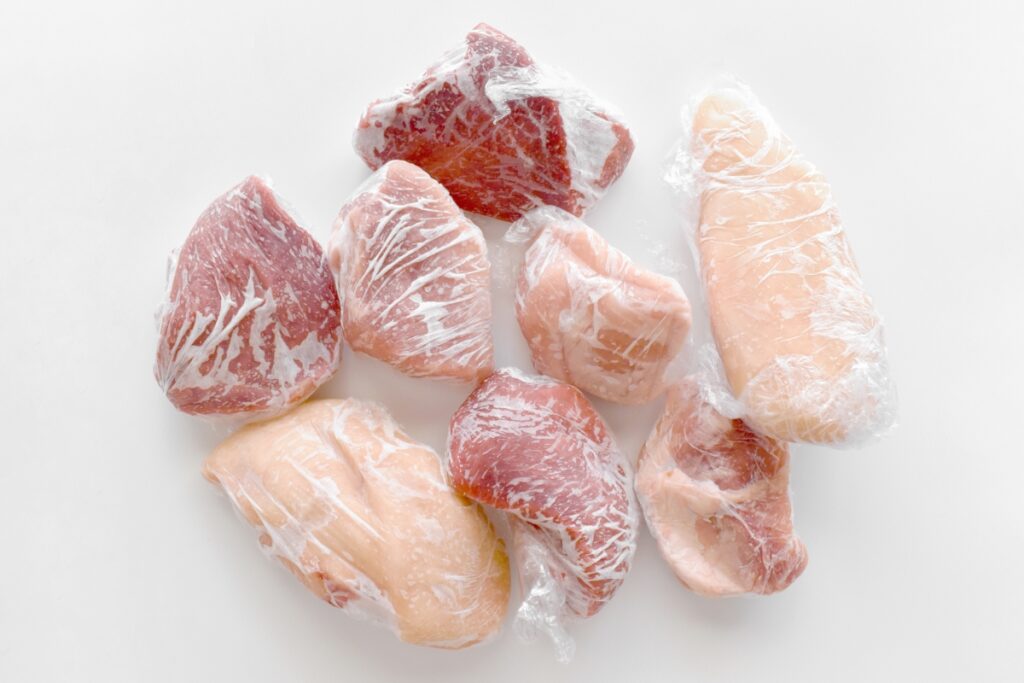
However, most parasites die when frozen for at least seven days at 0° F. This means that a steak made from whole lamb, beef, or venison that is raw in the middle is safer to eat if it is made from meat that has been frozen beforehand.
Is It Safe to Eat Completely Raw Steak?
Can Raw Steak Be Eaten Safely?
It is important to note that raw steak can contain harmful parasites as well as bacteria.
Most parasites can be destroyed by cooking or freezing the meat and bacteria can be eliminated by cooking. For this reason, it is generally recommended that steak should be cooked before being consumed.
If you still choose to eat raw meat, you should know a few things that significantly reduce your risk of getting sick.
What Kind of Steak Can Be Eaten Raw?
Beef can usually be eaten raw without risk of illness. However, it is very important to handle the meat correctly (see below).

Chicken and pig meat should never be consumed raw, while lamb meat can be eaten raw if the meat has been handled properly and frozen beforehand.
You can never be completely sure that you won’t get sick if you eat raw meat. However, by following the tips below for preparing different steak dishes, you can greatly reduce the risk of food poisoning.
The same principles apply to all beef and frozen lamb.
How Can You Eat Raw Steak Safely?
When it comes to raw steak, you can never be 100% sure that you do not get sick. However, there are a few different raw meat dishes that can be consumed quite safely if they are made from high quality ingredients, if hygiene has been good and if the temperature has been correct from the start.
How to Prepare a Safe Carpaccio
One of the most popular varieties is beef carpaccio. This is a dish consisting of very thinly sliced raw beef, usually filet mignon, that is served with a variety of dressings and sauces. It is a popular appetizer in many restaurants, but it can also be a great entrée. The key to eating raw steak as safely as possible is to ensure that it is of the highest quality and that it has been properly stored and handled.

How to Prepare a Safe Steak Tartare
If you’re looking for something a bit more adventurous, you can try steak tartare, a raw beef dish. This is a dish made from ground beef that has been finely chopped or pulsed in a food processor. This dish is traditionally served with raw egg yolk, which in itself can pose a risk of food poisoning. Steak tartare can also be prepared without the egg by adding seasonings such as garlic, herbs, and capers.
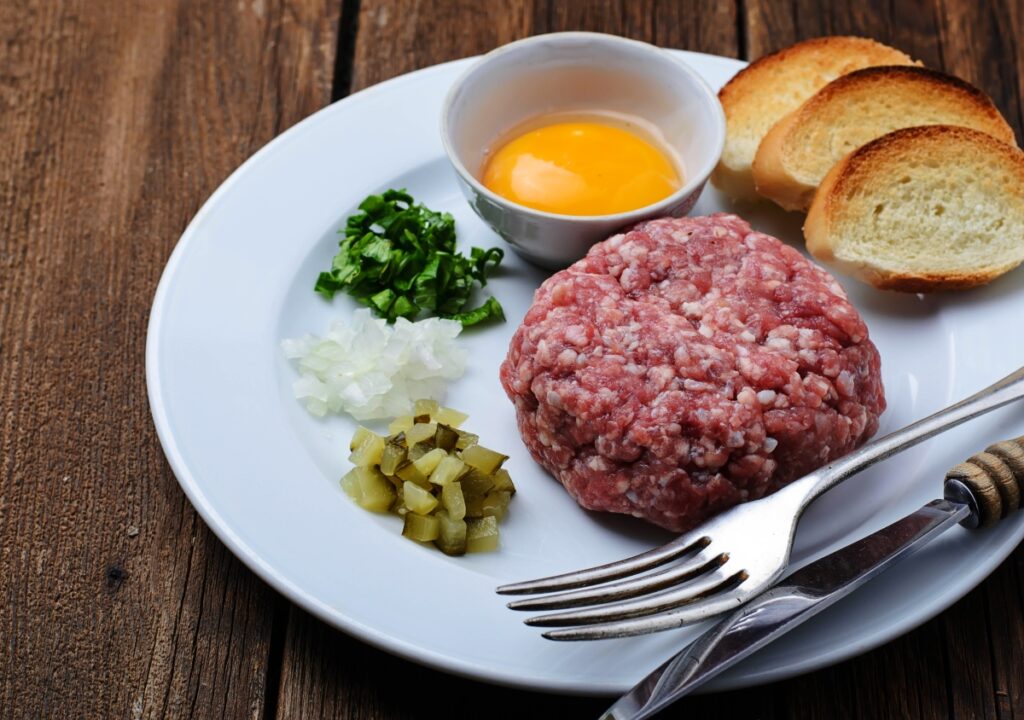
Tips when making steak tartare at home:
- The same principles apply as for carpaccio (see above):
- Buy controlled meat (not minced meat)
- Quickly roast the entire outside of the meat at high heat. Then trim off the cooked parts before processing the raw meat further. Use a clean cutting board and a clean knife.
- Grind the meat yourself. The meat grinder and other equipment used must be completely clean.
- Do not eat leftovers raw.
Is Raw Steak More Nutritious Than Cooked Steak?
When it comes to nutrition, the answer to whether a raw steak is more nutritious than a cooked steak depends on the individual’s diet. For those who eat an exclusively meat-based diet, raw steak might be the better choice. But for those who eat a reasonable amount of non-meat food, the vitamin losses from cooking may be outweighed by the convenience of cooked steak.
What Should I Do if I Ate Undercooked Steak?
It depends on the type of meat. See below for possible consequences. Always consult a doctor if you feel unwell after eating raw meat.
What Can Happen if I Eat Beef Steak Raw in the Middle?
Beef (not minced): If the meat has been heated on the outside, there is little risk of you getting sick even if the inside of the meat is raw.
Exception: If you injected marinade into the meat, the risk of getting sick is much higher if the meat is raw in the middle

Ground beef: If the meat is of good quality and has been handled properly, the risk of getting sick is relatively low even if the meat is raw in the middle. However, if the meat has not been handled properly, the risk of food poisoning is high. Seek medical advice if you experience any symptoms such as fever, stomach ache, or nausea in the next few days. In some cases, you may get sick much later.
What Can Happen if I Eat a Lamb Steak Raw in the Middle?
Lamb (not minced): if the meat has been frozen for at least three days and heated on the outside, there is little risk of getting sick even if the inside of the meat is raw. This is provided that the meat has been handled correctly in all other respects.
Exception: If you injected marinade into the meat, the risk of getting sick is much higher if the meat is raw in the middle.
If the meat has not been frozen before, there is a risk of getting sick, especially for pregnant women and people with compromised immune systems. Seek medical advice immediately if you feel ill.
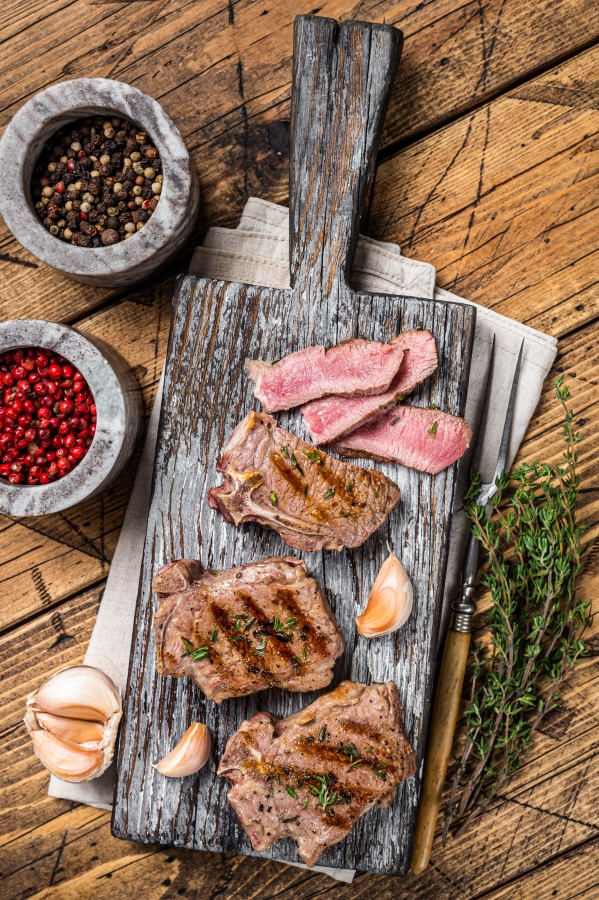
Ground lamb: If the meat has been frozen for at least three days, is of good quality, and has been handled properly, the risk of getting sick is relatively low, even if the meat is raw in the middle. However, if the meat has not been handled properly, the risk of food poisoning is high. Seek medical advice immediately if you experience any symptoms such as fever, stomach ache, or nausea in the next few days. In some cases, you may get sick much later.
What Can Happen if I Eat Pork Steak Raw in the Middle?
Pork (not minced meat): if the meat has been frozen beforehand and heated on the outside, there is little risk of getting sick even if the inside of the meat is raw.
Exception: If you injected marinade into the meat, the risk of getting sick is much higher if the meat is raw in the middle
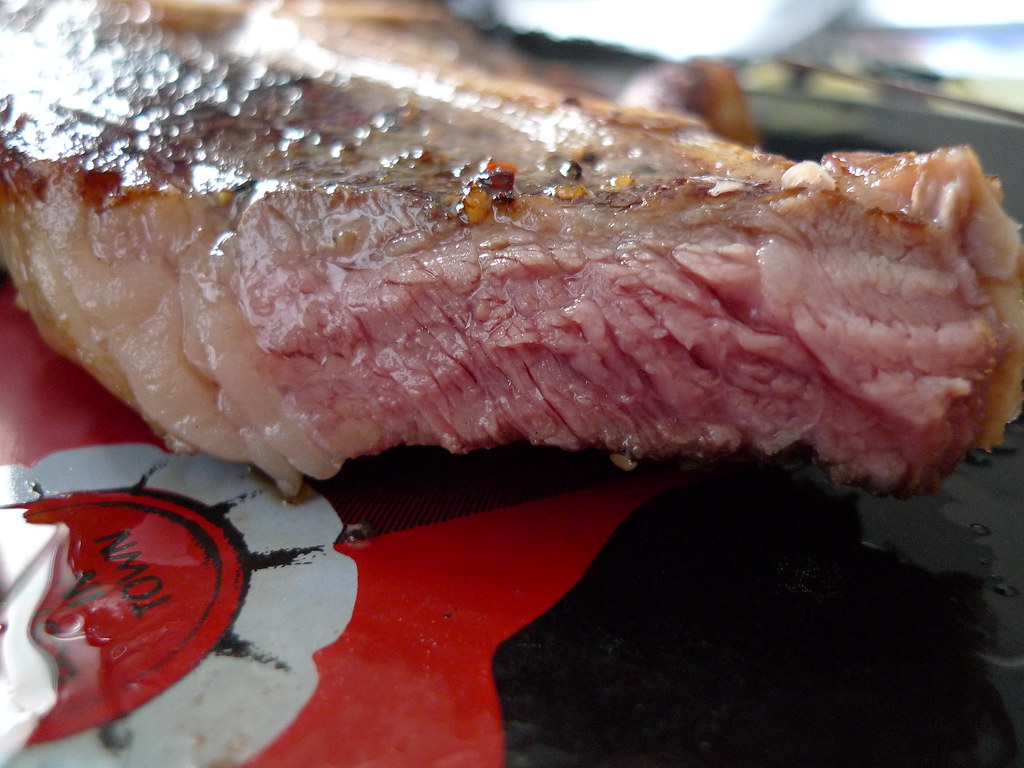
Photo: “Sous Vide FAIL – the proof” by In Memoriam: chrisbulle is licensed under CC BY 2.0.
Ground pork: If the meat is of good quality, has been frozen beforehand, and has been handled correctly, the risk of getting sick is relatively low even if the meat is raw in the middle. However, if the meat has not been handled properly, the risk of food poisoning is high. Seek medical advice if you experience any symptoms such as fever, stomach pain, or nausea in the next few days. In some cases, you may get sick much later.
Pork may contain trichinae, although the risk is low. Most variants of trichinae do not survive freezing, but there are exceptions. If you ingest raw pork and develop stomach pains (later fever and muscle pain), you should seek medical attention as soon as possible.
What Can Happen if I Eat Chicken Steak Raw in the Middle?
Chicken meat is injected with brine to tenderize the meat. This means that disease-causing bacteria can also be present on the inside of the meat.
There is therefore a high risk of becoming ill if any part of the meat is raw.
Seek medical advice if you experience fever, stomach pain, or nausea in the next few days. In some cases, you may get sick much later.
What Can Happen if I Eat Turkey Steak Raw in the Middle?
Turkey should not be eaten raw in the middle
Seek medical advice if you experience fever, stomach pain, or nausea in the next few days. In some cases, you may get sick much later.
Questions & Answers
Is It Ok to Eat Steak That is Pink in the Middle?
It depends on the type of meat. Beef is usually fine to eat, as is lamb if it has been frozen before cooking. Chicken should never be eaten pink.
What Happens if You Eat Slightly Undercooked Steak?
It depends on the type of meat. See above for the possible consequences.
How Pink Should the Middle of a Steak Be?
It depends on the type of meat. See the table above for the internal temperature that different types of meat should have to be safe to eat. Beef and lamb (if frozen before cooking) steak can be pink in the middle without being unsafe to eat.
Can Steak Be a Little Brown Raw?
A steak can be a little bit brown, even when raw. This is due to oxidation – a chemical change in the myoglobin of the beef that occurs after about five days of refrigeration storage. Contrary to what one might think, this does not mean the steak has spoiled. As long as there are no other signs of spoilage, such as a pungent smell, the steak is still safe to eat. The US Department of Agriculture confirms that this discoloration is normal and should not be cause for alarm. Therefore, it is safe to cook and enjoy steaks that have turned a slight brownish color.
Sources
CDC – Centers for Disease Control and Prevention https://www.cdc.gov
USDA https://www.fsis.usda.gov/food-safety/safe-food-handling-and-preparation/food-safety-basics/safe-temperature-chart
